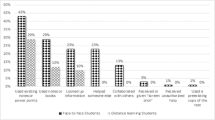Abstract
In this paper, we analyze how students select particular sections of required undergraduate courses at a regional public university in Texas. Specifically, we study how perceived instructor quality and other course section attributes, such as meeting time, impact enrollment. We find strong evidence that publicly available information about professor reputation influences students’ enrollment decisions. Sections taught by instructors who are more highly rated fill up more quickly, for our subset of required undergraduate courses. Sections taught by instructors rated as easier are also estimated to fill up more rapidly, in some specifications. We also find some evidence that the meeting times and days alsoinfluence enrollment decisions in systematic ways.
Similar content being viewed by others
Notes
There is some evidence that students at some elite institutions appear hungry for information about perceived instructor quality. Yale University recently shut down a student created website that allowed users to more easily compare student evaluations of courses. (Zimmerman 2014).
Other rules of thumb are sometimes used. VIFs thresholds of 2.5 and 10 are also commonly used thresholds to denote potential problems of multicollinearlity (O’brien 2007).
As OQ was collected before the enrollment period, there is no way for the PctCap to have any causal relationship towards OQ,.
References
Allison, P. D. (1999). Multiple regression: A primer. Pine Forge Press.
Babad, E., Darley, J. M., & Kaplowitz, H. (1999). Developmental aspects in students’ course selection. Journal of Educational Psychology, 91(1), 157.
Bachen, C. M., McLoughlin, M. M., & Garcia, S. S. (1999). Assessing the role of gender in college students’ evaluations of faculty. Communication Education, 48(3), 193–210.
Baldwin, T., & Blattner, N. (2003). Guarding against potential bias in student evaluations: what every faculty member needs to know. College Teaching, 51(1), 27–32.
Basow, S. A., & Silberg, N. T. (1987). Student evaluations of college professors: are female and male professors rated differently? Journal of Educational Psychology, 79(3), 308.
Benton, S. L., Cashin, W. E., & Kansas, E. (2012). IDEA PAPER# 50 Student Ratings of Teaching: A Summary of Research and Literature.
Bettinger, E., & Long, B. T. (2004). Do college instructors matter? The effects of adjuncts and graduate assistants on students’ interests and success (No. w10370). National Bureau of Economic Research.
Burnkrant, R. E., & Cousineau, A. (1975). Informational and normative social influence in buyer behavior. Journal of Consumer Research, 2(3), 206–215.
Centra, J. A. (2003). Will teachers receive higher student evaluations by giving higher grades and less course work? Research in Higher Education, 44(5), 495–518.
Cohen, J. B., & Golden, E. (1972). Informational social influence and product evaluation. Journal of Applied Psychology, 56(1), 54.
D’Apollonia, S., & Abrami, P. C. (1997). Navigating student ratings of instruction. American Psychologist, 52(11), 1198.
Davison, E., & Price, J. (2009). How do we rate? an evaluation of online student evaluations. Assessment and Evaluation in Higher Education, 34(1), 51–65.
Delucchi, M., & Korgen, K. (2002). We’re the customer-We pay the tuition: student consumerism among undergraduate sociology majors. Teaching Sociology, 30(1), 100–107.
DesJardins, S. L., Ahlburg, D. A., & McCall, B. P. (2006). An integrated model of application, admission, enrollment, and financial aid. Journal of Higher Education, 77(3), 381–429.
Deutsch, M., & Gerard, H. B. (1955). A study of normative and informational social influences upon individual judgment. The Journal of Abnormal and Social Psychology, 51(3), 629.
Leppel, K. (1993). Logit estimation of a gravity model of the college enrollment decision. Research in Higher Education, 34(3), 387–398.
Lomas, L. (2007). Are students customers? perceptions of academic staff. Quality in Higher Education, 13(1), 31–44.
Manski, C. F. (1983). College choice in America. Harvard University Press.
Marschak, J. (1960). Binary-choice constraints and random utility indicators. In Proceedings of a symposium on mathematical methods in the social sciences (pp. 19–38).
McFadden, D. (2001). Economic choices. American Economic Review, 351–378.
McMurtry, J. (1991). Education and the market model. Journal of Philosophy of Education, 25(2), 209–217.
Montmarquette, C., Cannings, K., & Mahseredjian, S. (2002). How do young people choose college majors? Economics of Education Review, 21(6), 543–556.
NCES. 2012. Fast Facts. http://nces.ed.gov/fastfacts/display.asp?id=84. Accessed 15 Dec 2013.
O’brien, R. M. (2007). A caution regarding rules of thumb for variance inflation factors. Quality & Quantity, 41(5), 673–690.
Otto, J., Sanford, D. A, Jr, & Ross, D. N. (2008). Does ratemyprofessor.com really rate my professor? assessment and evaluation in. Higher Education, 33(4), 355–368.
Tipoe, E. (2013). Course Enrollment Decisions: The Substitutability of Online Ratings Websites for Official Professor Evaluations. https://www.econ.berkeley.edu/sites/default/files/Tipoe.pdf. Accessed 5 January 2014.
Train, K. E. (2009). Discrete choice methods with simulation. Cambridge University Press.
Wilhelm, W. B. (2004). The relative influence of published teaching evaluations and other instructor attributes on course choice. Journal of Marketing Education, 26(1), 17–30.
Woodall, T., Hiller, A., & Resnick, S. (2014). Making sense of higher education: students as consumers and the value of the university experience. Studies in Higher Education, 39(1), 48–67.
Zimmerman, J. (2014). The Real Scandal behind the Yale course Web site. The Washington Post. http://www.washingtonpost.com/opinions/the-real-scandal-behind-the-yale-course-web-site/2014/01/24/f719ef56-8449-11e3-9dd4-e7278db80d86_story.html. Accessed 2 Feb 2014.
Author information
Authors and Affiliations
Corresponding author
Rights and permissions
About this article
Cite this article
Brown, C.L., Kosovich, S.M. The Impact of Professor Reputation and Section Attributes on Student Course Selection. Res High Educ 56, 496–509 (2015). https://doi.org/10.1007/s11162-014-9356-5
Received:
Published:
Issue Date:
DOI: https://doi.org/10.1007/s11162-014-9356-5




